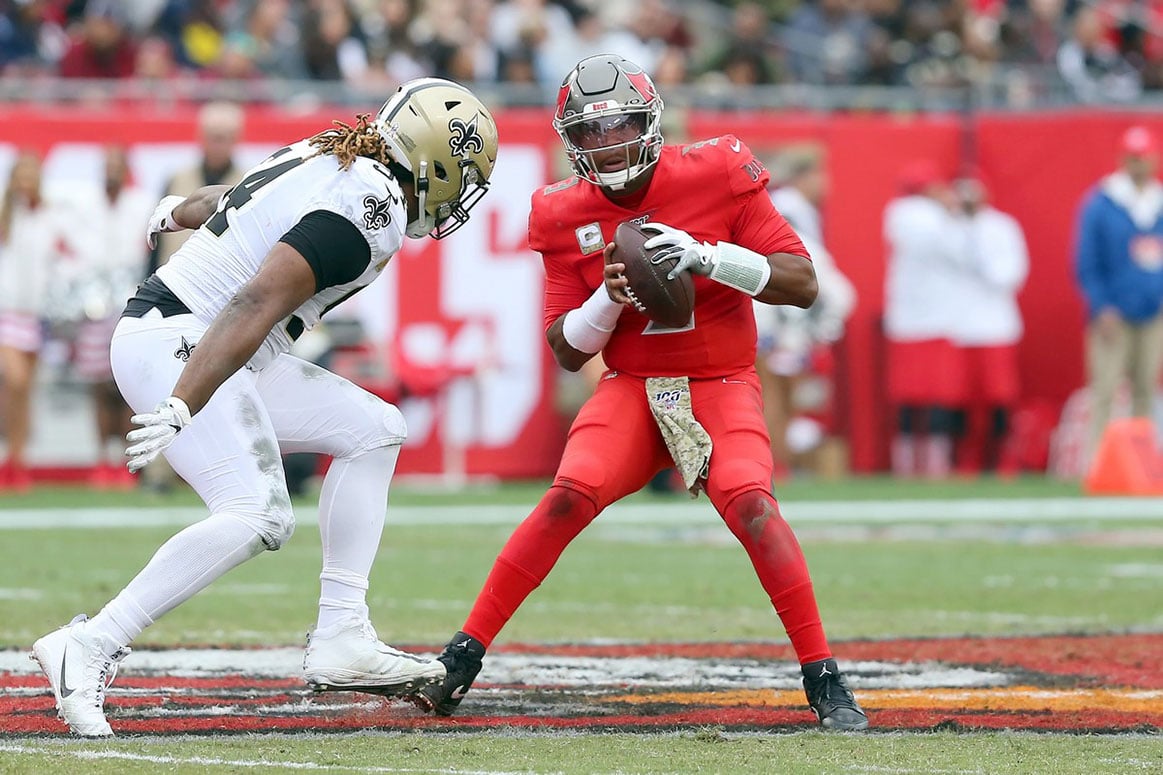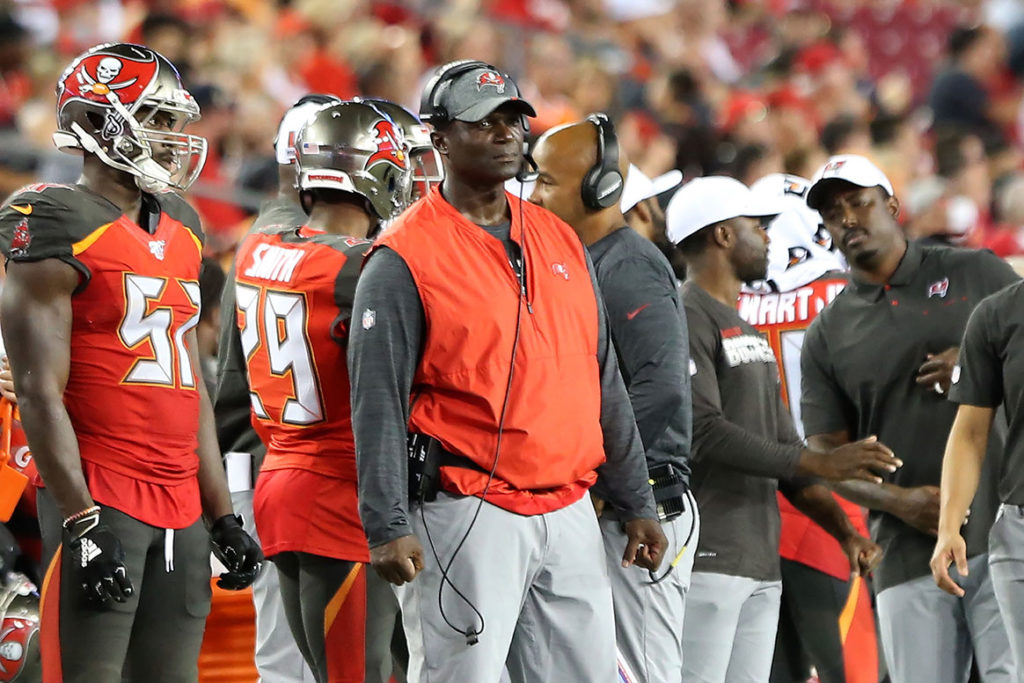All-Twenty Tuesday: Bucs Play Calling

We’re going to look at a couple of different aspects of the Bucs offense from last Sunday’s game, but in the first clip I did want to start by addressing some play calling and play design concerns.
The play above is from the Buccaneers’ first drive after going down 3-0 in the first quarter. The Bucs elected to run the ball on their first play for a six yard gain, and then passed the ball on their next two downs. Neither pass was successful. The pass above is the third-and-4 play.
The Bucs only needed to pick up four yards, and yet there was only one route that gave them that kind of quick option. Out of a bunch formation, which shows the wide receivers in a triangle formation, it is very common to execute a sail concept, which means you have route combinations that attack the short, intermediate and deep portions of the field. Usually one of them is open.
That’s what the Buccaneers were going for, and where I would have been totally fine with that kind of play, even if it didn’t work, on second down, I feel as though knowing the Saints are an aggressive team that there should have been quicker options knowing they would bring pressure. There just doesn’t seem to be many quick passing options in this offense.

Next I want to talk about tight end O.J. Howard — we’ll get to more play calling later.
Howard saw one target in the game against new Orleans, and with it he bobbled the ball behind his back and it was eventually intercepted. Howard didn’t see a single look in the game after that. When the game was over, many people, including myself, thought it was a bit harsh to just say “you messed up once, you’re done.” But that wasn’t Howard’s only mess up in the game.
The play directly before Howard’s bobble catch is shown above. In it, the Bucs ran counter to the right side with left guard Ali Marpet and Howard coming behind the line as pullers to lead block. As each moving blocker arrives at the contact point, it is Marpet’s job to engage and seal off the EMLOS (End Man on the Line Of Scrimmage). In the case of counter runs, that is the unblocked defensive end. Marpet does that. It is then Howard’s job to engage with whichever defender is either up and outside of Marpet’s block, or another player that has already crashed down. Wherever that player is, Howard has to seal them to the outside creating the hole for the running back to go through.
Instead, Howard seemed lost on who to block. Because of it, the player who was crashing down sealed the angle himself and was able to make the stop. That was the first mental mistake.

So when the infamous play above happened for Howard, that wasn’t just his first mental mistake of the day. It was his second in two straight plays, one as a receiver and one as a blocker.
Something is up with Howard this year because, even if you want to say he isn’t the best route runner or separator in the open field, he’s never looked this unfocused overall.

As for what happened when Howard was replaced, well, on the first play on the very next series, Winston threw a first down pass to tight end Cameron Brate. That was the first of what would be 14 targets and 10 catches for Brate during the game. Those 14 targets tied any single-game high Chris Godwin has had this season.
So in the debate of whether or not Bruce Arians’ offense can emphasize a tight end, we have a new wrinkle that was made loud and clear last Sunday.
It’s not that Arians and Leftwich don’t like using tight ends.
They don’t like using O.J. Howard.
Moving on to a different topic, I wanted to touch on the Buccaneers offensive line.
After the game on Sunday, a game in which the Buccaneers protection saw their quarterback get hit 12 times, Arians wasn’t overly critical of his offensive line. But where he can believe in them, what they’re putting out there consistently isn’t enough – not in this offense.
With the Bucs offense being as vertical based as it is, they are asking Winston to execute longer drop backs, holding onto the ball for much closer to three seconds than two. This Tampa offensive line just isn’t built for that, and the constant pressure on the pocket gave evidence to that.
In the two plays above, there really wasn’t even any place for Winston to throw the ball by the time the pressure was in his face. All of the routes down the field were still developing. This is the rift between what the Bucs want to do and the personnel they have. They want to push the ball down the field. They want to run longer route. They want to be vertical in what they do in the passing attack. But they don’t have an offensive line that can make that happen, at least not consistently. Sometimes it has worked, but with 60-70 offensive snaps per game, it has to hold up more than a handful of snaps.
This offensive game plan/design is putting so much stress on the offensive line and on Winston to hold onto the ball in order for wide receivers (who aren’t that great at separating anyways) to get far down the field before they turn and look.
No one wants another dink-and-dunk offense. But the one the Bucs currently have is almost too much for the trenches to handle.
Finally let’s bring it all back around to some play calling. On this team, there are offensive line concerns, there are receiving weapon concerns (separation and what they’re being asked to do), and there are also play calling concerns.
In the play above, the Bucs were faced with a first-and-goal from the 1-yard line. They opted to run a slant pass. I don’t hate it, but there’s no doubt that it is one of the more difficult plays you can run. It still requires a lot of moving parts, and any pass play contains a higher degree of difficultly than a run.
I really didn’t hate the play itself, but my question is: why no QB sneak?
After failing on first down, the Bucs then went shotgun at the 1-yard line. I understand that when you get close to the goal line space becomes a premium. Sometimes you have to create some yourself in unique ways. Shotgun can be one of them. But it’s also funny to me when I watch offensive coordinators work so damn hard to move the ball up the field, fighting for every single yard they can get, and then when they get as close as possible to scoring without quite scoring, they voluntarily choose to back themselves up five yards to start a play.
My question again: why no QB sneak?
This Bucs team has talent, especially on the offensive side. You can see that in the number they put up, even in losses. But just because they’re putting up numbers doesn’t mean they’re at optimum efficiency or maximizing what they have. They’re still not cohesive in a lot of ways – from the players to the play callers
Trevor Sikkema is the Tampa Bay Buccaneers beat reporter and NFL Draft analyst for PewterReport.com. Sikkema, an alumnus of the University of Florida, has covered both college and professional football for much of his career. As a native of the Sunshine State, when he's not buried in social media, Sikkema can be found out and active, attempting to be the best athlete he never was. Sikkema can be reached at: [email protected]







